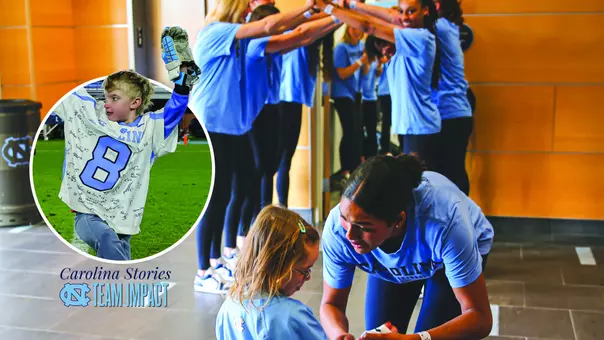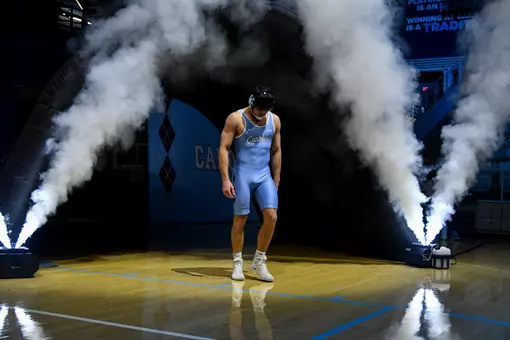University of North Carolina Athletics

Carolina's Graduation Success Rate rose two percent from a year ago.
UNC's Graduation Success Rate Rises In NCAA Data
November 8, 2017 | General, Academics, Student-Athlete Development
CHAPEL HILL—The University of North Carolina's Graduation Success Rate for incoming student-athletes from 2007-2010 is 84 percent, an increase of two percent from a year ago, in data released today by the NCAA.
The Graduation Success Rate measures graduation rates for student-athletes by team, taking into account student-athletes who are on scholarship their first year and who graduate from their respective university or leave the program via transfer to another university or professional opportunities while in good academic standing.
"Carolina is a world-class university and as proud as we are of our athletic success, we're even more proud when our students reach their ultimate goal of earning a UNC degree, so we are excited to see these Graduation Success Rates trending higher," says director of athletics Bubba Cunningham. "Much of that stems from the students' hard work, but it also is a result of the work our coaches have done to increase the academic profile of the students they are recruiting."
The University's four-year Federal Graduation Rate, which penalizes a school when players leave early for various reasons including the opportunity to play professionally, also improved a point to 69 percent.
Nine Carolina teams scored 100 percent for the four-year period in their respective GSRs including men's and women's fencing, field hockey, women's golf, gymnastics, women's lacrosse, women's swimming and diving, men's tennis and volleyball.
Nineteen sports topped 80 percent and 23 sports reached at least 75 percent in the GSR. It's the 13th consecutive 100 percent finish for gymnastics, 12th straight for women's golf and ninth for swimming and diving.
Eighteen of Carolina's 28 teams exceeded the national average in their respective sports and a 19th tied the national average. Those that exceeded the national average were baseball, men's and women's cross country, men's and women's fencing, field hockey, women's golf, gymnastics, men's and women's lacrosse, men's and women's swimming and diving, men's tennis, men's and women's track and field and volleyball. Rowing tied its national average.
Men's and women's fencing, field hockey, women's golf, gymnastics, women's lacrosse, women's swimming and diving, men's tennis and volleyball had the highest GSRs in the ACC in their respective sports.
Three programs – men's soccer (plus 12%), men's golf (plus 11%) and baseball (plus 10%) earned double-digit increases in the GSR. Football (plus 7%), softball (plus 6%), women's lacrosse (plus 4%) and men's cross country and track and field (plus 1%) also earned higher scores in this report.
Cunningham notes that the NCAA's Academic Progress Rate, which is released each year in the spring, is a better real-time indicator of academic achievement. "We have seen significant increases in the last five years in our APRs, which will lead to even higher graduation rates in the years to come."
Men's basketball would have posted the same GSR as a year ago, but for a statistical quirk in the computations that penalizes a school when professional players take classes to finish their degree.
"Players who leave in good academic standing don't count against a school, but when those players begin to take classes to finish their degree, which obviously we all agree is a good thing, they count against you if the degree is not completed within the six-year window. That happens frequently and needs to be addressed by the NCAA," says Cunningham.
The Graduation Success Rate measures graduation rates for student-athletes by team, taking into account student-athletes who are on scholarship their first year and who graduate from their respective university or leave the program via transfer to another university or professional opportunities while in good academic standing.
"Carolina is a world-class university and as proud as we are of our athletic success, we're even more proud when our students reach their ultimate goal of earning a UNC degree, so we are excited to see these Graduation Success Rates trending higher," says director of athletics Bubba Cunningham. "Much of that stems from the students' hard work, but it also is a result of the work our coaches have done to increase the academic profile of the students they are recruiting."
The University's four-year Federal Graduation Rate, which penalizes a school when players leave early for various reasons including the opportunity to play professionally, also improved a point to 69 percent.
Nine Carolina teams scored 100 percent for the four-year period in their respective GSRs including men's and women's fencing, field hockey, women's golf, gymnastics, women's lacrosse, women's swimming and diving, men's tennis and volleyball.
Nineteen sports topped 80 percent and 23 sports reached at least 75 percent in the GSR. It's the 13th consecutive 100 percent finish for gymnastics, 12th straight for women's golf and ninth for swimming and diving.
Eighteen of Carolina's 28 teams exceeded the national average in their respective sports and a 19th tied the national average. Those that exceeded the national average were baseball, men's and women's cross country, men's and women's fencing, field hockey, women's golf, gymnastics, men's and women's lacrosse, men's and women's swimming and diving, men's tennis, men's and women's track and field and volleyball. Rowing tied its national average.
Men's and women's fencing, field hockey, women's golf, gymnastics, women's lacrosse, women's swimming and diving, men's tennis and volleyball had the highest GSRs in the ACC in their respective sports.
Three programs – men's soccer (plus 12%), men's golf (plus 11%) and baseball (plus 10%) earned double-digit increases in the GSR. Football (plus 7%), softball (plus 6%), women's lacrosse (plus 4%) and men's cross country and track and field (plus 1%) also earned higher scores in this report.
Cunningham notes that the NCAA's Academic Progress Rate, which is released each year in the spring, is a better real-time indicator of academic achievement. "We have seen significant increases in the last five years in our APRs, which will lead to even higher graduation rates in the years to come."
Men's basketball would have posted the same GSR as a year ago, but for a statistical quirk in the computations that penalizes a school when professional players take classes to finish their degree.
"Players who leave in good academic standing don't count against a school, but when those players begin to take classes to finish their degree, which obviously we all agree is a good thing, they count against you if the degree is not completed within the six-year window. That happens frequently and needs to be addressed by the NCAA," says Cunningham.
Carolina Stories: Inspiring Through Team IMPACT
Monday, December 22
WBB: Post-Charleston Southern Press Conference - Dec. 21, 2025presser
Sunday, December 21
UNC Women's Basketball: Tar Heels Topple Charleston Southern, 93-74
Sunday, December 21
UNC Men's Basketball: Tar Heels Escape Ohio State, 71-70
Saturday, December 20




